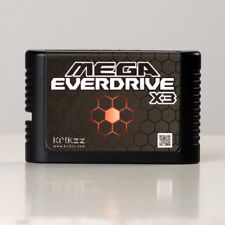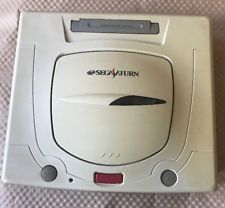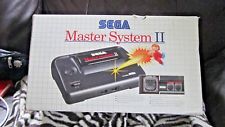|
April 3rd, 2006, 01:10 Posted By: wraggster
All info from my pal Dark Watchers Console Site

Sega Saturn
In development for 2 to 3 years by Sega of Japan, The project known merely as GigaDrive (A word play for a more powerful Megadrive) began with a goal of being the most powerful 2D console to date with 3D capability based on their arcade Model 1 hardware.
Initially the goal was to surpass another CD-based console called the 3DO. In November of 1993, technical specs for 32-bit CD-based console by Sony had surfaced. Not being pleased with the projects 3D capability (compared to Sony’s), Sega of Japan’s engineers scrambled to improve on the design.
Using planet-naming conventions used for their other projects (Like Mars and Neptune), the new console was called the Sega Saturn. It was released in Japan on November 22nd 1994, and was an immediate success. Sega had finally made a serious mark in Japan by even surpassing their long-term rival Nintendo (Sega consoles were more successful in the US markets in the past).
They would however have to face a new contender to the market. Sony finally released the Playstation, and used their financial stability (deep ass pockets) to produce a strong marketing campaign, garner the attention of 3rd party developers, and purchase exclusive rights to game titles. Sony ambitiously cornered popular game genres in Japan, but Sega countered with impressive 2D shooters, fighting games, and hentai titles (those Japanese...hahaha). The Saturn still sold remarkably well, and so Sega set their eyes on other markets.
The original scheduled release for the US Saturn was supposed to be ‘Saturnday’ September 2nd 1995. However with the Sony Playstation US premier looming over the horizon, Sega chose to release their console 4 months sooner (May 11th, 1995). They got the jump on the market that they needed, but caught developers off guard. The console was released with a high $399 price tag, and a lack of 3rd Party software titles.
Even after the stinging failure of the 32X, the Saturn still managed to sell pretty well initially. However, the Sony Playstation was eventually released for $100 cheaper, and eventually took over the US market. The Saturn failed to capture the success it garnered in Japan. So what happened?
The Saturn boasted an amazing amount of processors including it’s dual Hitachi CPU processors. However, this caused problems in game development. Apparently the two CPU’s did not run in tandem, and could not access memory at the same time. The complexity either caused developers to shy away from the Saturn, or develop games in a manner that didn’t fully utilize the systems capabilities (3rd Party developers initially designed games only using a single processor). Eventually developers found away around Saturn’s complexity, but not soon enough.
Another contributing factor to Saturn's struggle in America was Sega of America's management. Sega’s mishandling and eventual abandonment of 32X had already damaged Sega’s credibility. The early release left some retail stores without Saturn stock, and the initial high price did not help sales. Also, Sega of America did a piss poor job of advertising the Sega Saturn. They also made the mistake of not bringing many quality Japanese Saturn game titles over to the United States. Eventually the market grew more hostile with the release of Nintendo’s 64-bit ‘next generation’ system.
The Saturn may not have done well in the American market, but in Japan the Saturn was a hot item. The console saw amazing game titles, which also became hot imports in America and Europe. The hardware specs were also licensed out to component manufacturers allowing them the ability to build their own model Saturns, and spread the console out further. These models were available in Japan only.
Shown above is the V-Saturn, which was developed by JVC. It is technically a clone of the Saturn with a different outward appearance, a different boot screen, and Photo CD reading compatibility with a JVC Twin Operator card. The Hi-Saturn was developed by Hitachi, and had native MPEG decompression for viewing VCD (Video CD). Another Hitachi model was released that also contained a modem, LCD play screen, and built in navigation systems for use in vehicles. Finally a Skeleton Saturn was released with a case that showcased the units circuitry.
All in all Saturn was an amazing console that produced beautiful 2D gaming, and brilliant 3D titles toward the end of it’s life cycle. Saturn was supported in the US until 1998 and in Japan until 1999.
FACT: One of the more innovative concepts of the Saturn was the cartridge slot. The slot itself was not meant for gaming, but could be used in a variety of ways (EXAMPLES). The more common uses were for an external memory cart for save game portability, and for cheat devices such as the ‘Game Shark’. However the slot was also used for Sega Netlink. This was a 28.8 modem built in a cart that could be used to access the web, check email, and even play someone online who also has Netlink. Another use that was never seen outside of Japan were RAM carts. These carts provided the Saturn with up to 4Mb additional RAM for better and more fluid sprite animation in certain select games. Goes to show some of the things we missed out on in America.
Some Game Screenshots:




Thanks again to Dark Watchers Console Site for the above info 
For more information and downloads, click here!
 There are 18 comments - Join In and Discuss Here There are 18 comments - Join In and Discuss Here
|
|
 Sega Everdrive Flashcart
Sega Everdrive Flashcart










